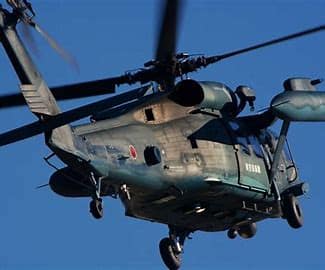I’m compiling government-released statistical information. For more detailed data, please refer to the Government Statistics Portal (e-Stat) or the statistical data published by respective government ministries and agencies.
“
The record of emergency patient transport by the Self-Defense Forces.
The achievement data for emergency patient transport by the Self-Defense Forces on an annual basis is unavailable at the moment. However, records exist for the Self-Defense Forces’ disaster relief missions and unexploded ordnance disposal categorized by region. In the Reiwa 4th fiscal year, there were:
- Hokkaido: 3 cases
- Tokyo: 23 cases
- Niigata: 2 cases
- Ishikawa: 2 cases
- Aichi: 1 case
- Shimane: 9 cases
- Yamaguchi: 1 case
- Nagasaki: 50 cases
- Miyazaki: 1 case
- Kagoshima: 73 cases
- Okinawa: 142 cases
- Other regions: 10 cases
This accounts for a total of 317 instances reported. Additionally, detailed monthly achievements are provided, showcasing the number of disaster relief missions and unexploded ordnance disposal incidents from April to March. This breakdown offers a visualization of the distribution of activities throughout each month within the fiscal year.
| Hokkaido | Tokyo | Niigata | Ishikawa | Aichi | Shimane | Yamaguchi | Nagasaki | Miyazaki | Kagoshima | Okinawa | other | total | |
| FY Reiwa 4 | 3 | 23 | 2 | 2 | 1 | 9 | 1 | 50 | 1 | 73 | 142 | 10 | 317 |
| April | 2 | 4 | 6 | 7 | 19 | ||||||||
| April | 1 | 2 | 6 | 10 | 9 | 1 | 29 | ||||||
| April | 3 | 3 | 6 | 16 | 1 | 29 | |||||||
| April | 3 | 1 | 4 | 3 | 8 | 6 | 2 | 27 | |||||
| April | 1 | 3 | 2 | 3 | 2 | 17 | 28 | ||||||
| April | 1 | 4 | 14 | 1 | 20 | ||||||||
| April | 1 | 1 | 3 | 4 | 9 | 18 | |||||||
| April | 3 | 8 | 5 | 13 | 1 | 30 | |||||||
| April | 1 | 2 | 4 | 5 | 14 | 1 | 27 | ||||||
| April | 2 | 2 | 10 | 1 | 7 | 14 | 2 | 38 | |||||
| April | 2 | 1 | 2 | 10 | 10 | 25 | |||||||
| April | 1 | 1 | 1 | 4 | 6 | 13 | 1 | 27 | |||||
| total | 3 | 23 | 2 | 2 | 1 | 9 | 1 | 50 | 1 | 73 | 142 | 10 | 317 |
The annual records of emergency dispatches by the Self-Defense Forces.

The data presents the Air Self-Defense Force’s records of emergency scrambles, categorized annually by the originating country or region and further broken down by each regional air command.
In the Reiwa 4th fiscal year, there were a total of 778 emergency scrambles. Among these, the breakdown by country or region was: Russia with 150, China with 575, Taiwan with 0, North Korea with 0, and 53 others. Furthermore, categorized by regional air commands, the Northern Air Command conducted 116, the Central Air Command conducted 32, the Western Air Command conducted 115, and the Southwestern Air Command conducted 515 emergency scrambles. These figures depict the number of emergency scrambles handled by each regional command out of the total 778 scrambles.
In contrast, during the Reiwa 3rd fiscal year, a total of 1,004 emergency scrambles were conducted. The breakdown by country or region was: Russia with 266, China with 722, Taiwan with 3, North Korea with 0, and 13 others. The distribution across regional air commands was: the Northern Air Command conducted 217, the Central Air Command conducted 31, the Western Air Command conducted 104, and the Southwestern Air Command conducted 652 emergency scrambles.
| Japanese calendar | total | By Country/Region * Country/region includes estimates. | By Air Corps | |||||||||
| Russia | China | Taiwan | North Korea | other | plan | Northern Air Squadron | Chubu Air Force | Western Air Command | Southwest Air Force* | plan | ||
| FY Reiwa 4 | 778 | 150 | 575 | 0 | 0 | 53 | 778 | 116 | 32 | 115 | 515 | 778 |
| FY Reiwa 3 | 1,004 | 266 | 722 | 3 | 0 | 13 | 1,004 | 217 | 31 | 104 | 652 | 1,004 |
| FY Reiwa 2 | 725 | 258 | 458 | 0 | 0 | 9 | 725 | 206 | 36 | 79 | 404 | 725 |
| Heisei 31 / Reiwa year | 947 | 268 | 675 | 0 | 0 | 4 | 947 | 198 | 35 | 133 | 581 | 947 |
| Heisei 30 | 999 | 343 | 638 | 0 | 0 | 18 | 999 | 277 | 52 | 74 | 596 | 999 |
| Heisei 29 | 904 | 390 | 500 | 3 | 0 | 11 | 904 | 330 | 56 | 41 | 477 | 904 |
| Heisei 28 | 1,168 | 301 | 851 | 8 | 0 | 8 | 1,168 | 265 | 34 | 66 | 803 | 1,168 |
| Heisei 27 | 873 | 288 | 571 | 2 | 0 | 12 | 873 | 205 | 50 | 87 | 531 | 873 |
| Heisei 26 | 943 | 473 | 464 | 1 | 0 | 5 | 943 | 286 | 102 | 87 | 468 | 943 |
| Heisei 25 | 810 | 359 | 415 | 1 | 9 | 26 | 810 | 222 | 86 | 100 | 402 | 810 |
| Heisei 24 | 567 | 248 | 306 | 1 | 0 | 12 | 567 | 139 | 65 | 45 | 318 | 567 |
| Heisei 23 | 425 | 247 | 156 | 5 | 0 | 17 | 425 | 158 | 54 | 47 | 166 | 425 |
| Heisei 22 | 386 | 264 | 96 | 7 | 0 | 19 | 386 | 151 | 80 | 40 | 115 | 386 |
| Heisei 21 | 299 | 197 | 38 | 25 | 8 | 31 | 299 | 111 | 55 | 32 | 101 | 299 |
| Heisei 20 | 237 | 193 | 31 | 7 | 0 | 6 | 237 | 121 | 46 | 28 | 42 | 237 |
| Heisei 19 | 307 | 253 | 43 | 3 | 0 | 8 | 307 | 173 | 54 | 36 | 44 | 307 |
| Heisei 18 | 239 | 196 | 22 | 8 | 0 | 13 | 239 | 123 | 57 | 25 | 34 | 239 |
| Heisei 17 | 229 | 116 | 107 | 2 | 0 | 4 | 229 | 90 | 15 | 73 | 51 | 229 |
| Heisei 16 | 141 | 118 | 13 | 0 | 0 | 10 | 141 | 88 | 22 | 18 | 13 | 141 |
| Heisei 15 | 158 | 124 | 2 | 18 | 0 | 14 | 158 | 90 | 29 | 11 | 28 | 158 |
A comparison of emergency scramble numbers between Reiwa 3rd and Reiwa 4th years.
A comparison of emergency scrambles conducted by the Air Self-Defense Force in the Reiwa 4th and Reiwa 3rd fiscal years reveals distinct trends:
Total Counts:
Reiwa 4th year: 778 scrambles
Reiwa 3rd year: 1,004 scrambles
The Reiwa 3rd year had a higher number of emergency scrambles.
Country/Region Breakdown:
Both years witnessed Russia and China causing the most emergency scrambles. In the Reiwa 4th year, Russia recorded 150 and China 575 scrambles, while in the Reiwa 3rd year, Russia had 266 and China 722 scrambles. Other countries/regions accounted for 53 scrambles in Reiwa 4th and 13 scrambles in Reiwa 3rd.
Emergency scrambles originating from Taiwan and North Korea were limited in both years.
Regional Air Command Breakdown:
In the Reiwa 4th year, the Southwestern Air Command executed 515 emergency scrambles, surpassing other commands. Similarly, in the Reiwa 3rd year, the Southwestern Air Command led with 652 scrambles.
While the emergency scramble counts for the Central and Western Air Commands were similar in both years, the Northern Air Command’s performance varied.
This comparison provides insights into how the Air Self-Defense Force’s emergency scramble achievements have shifted annually, delineated by country/region and regional air commands.
Annual Disaster Dispatch Records by the Self-Defense Forces

“Detailing the annual records of Self-Defense Forces’ disaster dispatches and unexploded ordnance disposal, including specific data such as the nature of dispatched aid, affected regions, and the count and types of unexploded ordnance disposed of.
The number of disaster dispatches has fluctuated over the past few years. In the fiscal year of Reiwa 4, 381 disaster dispatches were carried out, slightly lower than the 383 dispatches in the preceding Reiwa 3. Further back, in Reiwa 2, there were 531 dispatches, while in the fiscal years of Heisei 31 and Reiwa 1, 449 dispatches were made. These figures indicate the variability of dispatches, likely influenced by changing disaster demands and circumstances.
Even during the Heisei era, disaster dispatches were consistently conducted. There were notably high numbers in Heisei 18 and 17, recording 812 and 892 dispatches, respectively. However, from Heisei 20 onwards, the numbers ranged between 606 and 679. Across the late Heisei and early Reiwa periods, while fluctuations in dispatch counts occurred, the sustained engagement of the Self-Defense Forces in emergency disaster relief activities remained evident.”
| Japanese calendar | Number of disaster dispatches |
| FY Reiwa 4 | 381 |
| FY Reiwa 3 | 383 |
| FY Reiwa 2 | 531 |
| Heisei 31 / Reiwa first year | 449 |
| Heisei 30 | 443 |
| Heisei 29 | 503 |
| Heisei 28 | 516 |
| Heisei 27 | 541 |
| Heisei 26 | 521 |
| Heisei 25 | 555 |
| Heisei 24 | 520 |
| Heisei 23 | 587 |
| Heisei 22 | 529 |
| Heisei 21 | 559 |
| Heisei 20 | 606 |
| Heisei 19 | 679 |
| Heisei 18 | 812 |
| Heisei 17 | 892 |
| Heisei 16 | 884 |
| Heisei 15 | 811 |
| Heisei 14 | 868 |
| Heisei 13 | 845 |
| Heisei 12 | 878 |
The records of unexploded ordnance disposal by the Self-Defense Forces and the number of disposals specifically in Okinawa.
The records of unexploded ordnance and explosive hazardous material disposal by the Ground Self-Defense Force and Maritime Self-Defense Force have varied annually. In the fiscal year 2022, the Ground Self-Defense Force handled 1,372 cases with a total disposal weight of 41.9 tons. Additionally, 467 cases involving explosive materials were processed, amounting to 13.1 tons. The Maritime Self-Defense Force dealt with 3,779 explosive hazardous items, with a disposal weight of 2.7 tons.
In the fiscal year 2021, the Ground Self-Defense Force handled 1,255 cases with a total disposal weight of 31.9 tons. There were 423 cases involving explosive materials, amounting to 11.5 tons. The Maritime Self-Defense Force processed 2,646 explosive hazardous items, totaling 4.0 tons.
Similarly, in the fiscal year 2020, the Ground Self-Defense Force handled 1,194 cases with a total disposal weight of 21.9 tons. There were 510 cases involving explosive materials, totaling 12.8 tons. The Maritime Self-Defense Force disposed of 2 mines, amounting to 1.0 ton.
Contrastingly, in the fiscal year 2019, the Ground Self-Defense Force handled 1,441 cases with a total disposal weight of 33.2 tons. There were 529 cases involving explosive materials, totaling 18.3 tons. The Maritime Self-Defense Force dealt with 509 explosive hazardous items, totaling 3.5 tons.
Moreover, in the fiscal year 2018, the Ground Self-Defense Force handled 1,480 cases with a total disposal weight of 53.1 tons. There were 675 cases involving explosive materials, totaling 19.7 tons. The Maritime Self-Defense Force disposed of 4,456 explosive hazardous items, totaling 2.8 tons.
| JGSDF | Maritime Self-Defense Force | |||||||||||
| Japanese calendar | Unexploded ordnance and other explosives | mine | Other explosive hazardous materials | |||||||||
| Number of cases processed | Processing weight | Number of processed pieces | Processing weight | Number of processed pieces | Processing weight | |||||||
| FY Reiwa 4 | 1,372 | [ | 467 | ] | 41.9 | [ | 13.1 | ] | 0 | 0.0 | 3,779 | 2.7 |
| FY Reiwa 3 | 1,255 | [ | 423 | ] | 31.9 | [ | 11.5 | ] | 0 | 0.0 | 2,646 | 4.0 |
| FY Reiwa 2 | 1,194 | [ | 510 | ] | 21.9 | [ | 12.8 | ] | 2 | 1.0 | 466 | 2.6 |
| Heisei 31 / Reiwa first year | 1,441 | [ | 529 | ] | 33.2 | [ | 18.3 | ] | 0 | 0.0 | 509 | 3.5 |
| Heisei 30 | 1,480 | [ | 675 | ] | 53.1 | [ | 19.7 | ] | 0 | 0.0 | 4,456 | 2.8 |
* [ ] indicates the number of cases processed and the weight of processing in Okinawa.




